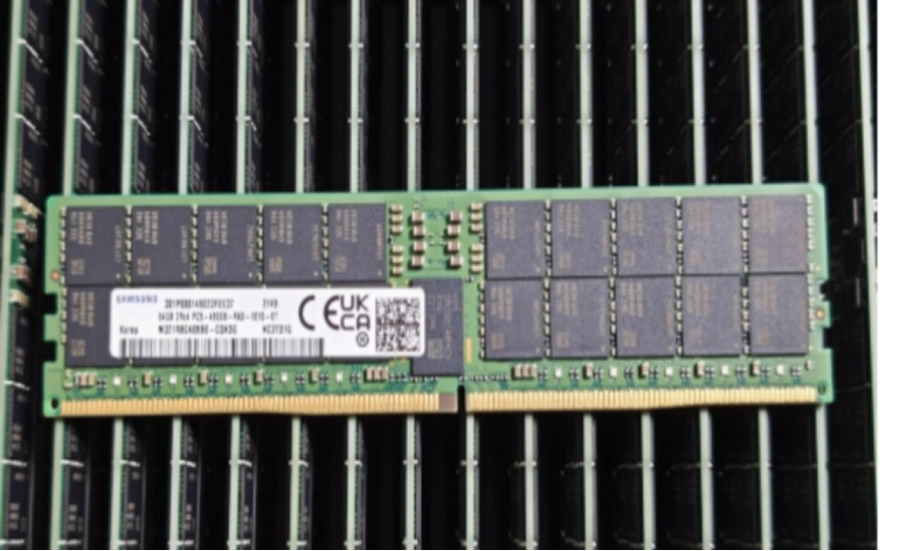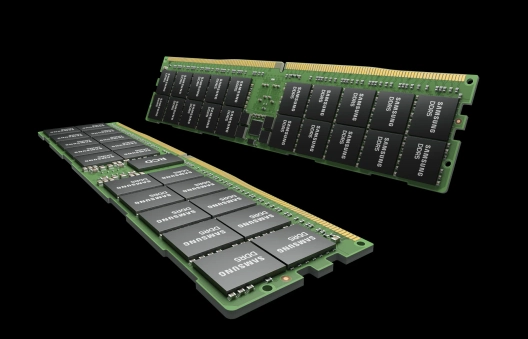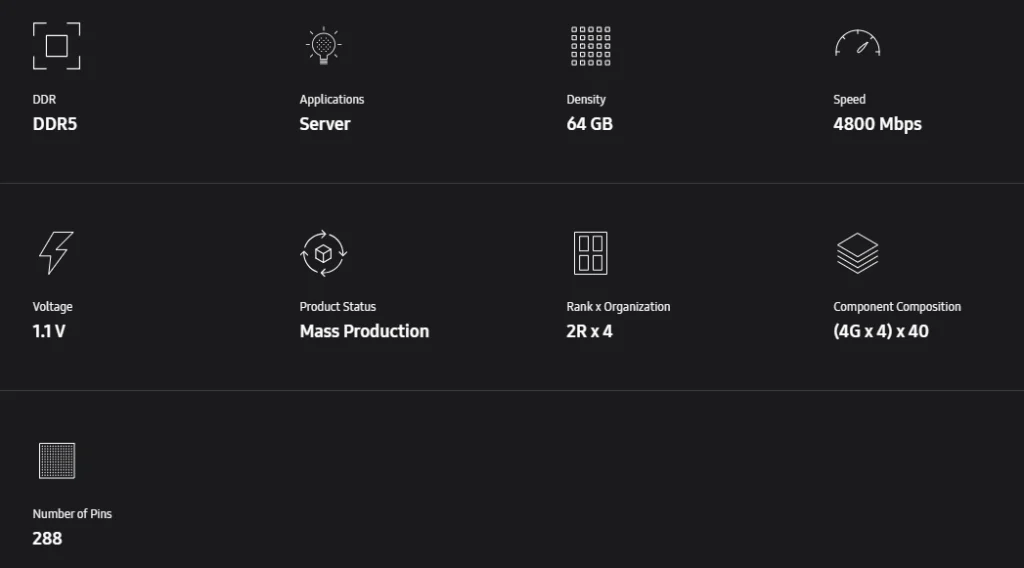Server memory needs to be fast, trusty, and energy-saving for today’s demanding applications. The Samsung M321R8GA0BB0-CQK is a top DDR5 ECC RDIMM choice for enterprise systems. This article compares it to competitors like Kingston, Micron, and SK Hynix. It also explains why Huaying Hengtong is a great partner for your memory needs.

What Makes the Samsung M321R8GA0BB0-CQK a Strong Contender in DDR5 ECC RDIMM?
Key Features of Samsung M321R8GA0BB0-CQK
The Samsung M321R8GA0BB0-CQK is a DDR5 Registered DIMM (RDIMM) built for servers. It offers a 64GB capacity and runs at 4800 Mbps. Its 2Rx4 setup uses registers to boost clock, command, and control signals. This keeps signals clear and systems stable. That’s key for enterprise setups needing top performance. Pretty solid, right?
It also has an 8-bit parity signal for error correction (ECC). This catches and fixes data errors during transmission. It’s vital for critical tasks where mistakes aren’t an option. The module supports x4/x8 organization and up to 2 ranks per DIMM with 2DPC/3DPC setups. This flexibility fits many server designs.
Performance and Reliability in Server Environments
DDR5 tech brings fast data speeds and bigger bandwidth. This suits data-heavy tasks like AI processing, 5G networks, or high-performance computing. The M321R8GA0BB0-CQK uses smart power management to save energy. It also supports larger memory sizes. Its CL40 timing ensures steady latency across workloads. Plus, it’s RoHS-compliant, balancing green standards with strong performance.
Compatibility with Modern Server Architectures
The M321R8GA0BB0-CQK works with standard DDR5 RDIMM setups. It supports up to 2 ranks per DIMM and 2DPC configurations. This makes it great for scaling servers. It fits older systems upgrading to DDR5 or new setups with next-gen CPUs. You get smooth integration no matter the system.

How Does the Kingston KSM64RD8KBDY-48HM Compare to the Samsung M321R8GA0BB0-CQK?
Technical Specifications and Memory Capacity
The Kingston KSM64RD8KBDY-48HM is another DDR5 ECC RDIMM for servers. It also has a 64GB capacity and runs at about 4800 Mbps. But Samsung’s 2Rx4 setup gives it a slight edge in signal clarity and density. Kingston modules work across many platforms, but Samsung’s testing ensures tighter integration with specific ecosystems.
Performance Benchmarks in Real-world Applications
For tasks like virtualization or database hosting, Samsung’s register design boosts stability under heavy loads. Kingston performs well in standard settings. However, the M321R8GA0BB0-CQK often shows better heat management and fewer errors thanks to its strong ECC. Samsung’s power management also shines in long-running tasks where energy savings matter.
Value for Money and Availability
Kingston is often cheaper and widely available. It’s a budget-friendly pick for many. But the Samsung M321R8GA0BB0-CQK offers better value through top-notch engineering. Its reliability cuts long-term costs in enterprise setups. You pay a bit more upfront, but it saves money over time.
Is Micron’s MTC20F2085S1RC48BA1 a Better Choice Than Samsung M321R8GA0BB0-CQK?
Speed, Latency, and Power Efficiency Comparison
Micron’s MTC20F2085S1RC48BA1 is a strong DDR5 ECC RDIMM competitor. It matches Samsung’s speed at 4800 Mbps. Both have a CL40 timing for steady latency. But Samsung’s power management tech is a bit more efficient. This helps in big deployments where power costs add up. You save energy without losing speed.
ECC Functionality and System Stability
Both brands offer solid ECC features. Samsung adds an 8-bit parity signal to catch and fix errors. This is crucial for tasks like scientific computing or financial modeling. Even small errors can cause big problems. Samsung’s design ensures fewer issues, making it a trusty choice.
Deployment Scenarios and Use Cases
Micron modules work well in general servers. But Samsung’s M321R8GA0BB0-CQK adapts better to varied setups. Its x4/x8 organization and 2DPC/3DPC support fit AI clusters, real-time analytics, or other demanding systems. This flexibility makes it stand out for complex deployments.
Can SK Hynix HMCG88MEBRA109N Match the Performance of Samsung M321R8GA0BB0-CQK?
Bandwidth and Throughput Analysis
SK Hynix’s HMCG88MEBRA109N delivers strong DDR5 bandwidth. At 4800 Mbps, it’s close to Samsung’s speed. But in heavy multi-threaded tasks, Samsung handles I/O operations a bit better. This is key for AI inference or large simulations where data flow is critical. The difference is small but noticeable.
Durability Under Intensive Workloads
Samsung builds its modules for toughness. Registers improve clock sync, and ECC keeps errors low. This ensures steady performance during long, intense tasks. SK Hynix modules are solid, but Samsung’s design holds up better over time. It’s built to last in tough conditions.
Cost Efficiency for Enterprise Solutions
SK Hynix may cost less per GB upfront. But Samsung’s M321R8GA0BB0-CQK offers better long-term value. Its reliability reduces downtime and maintenance costs. For enterprises, this means a lower total cost over the module’s life. It’s a smart investment for big projects.

Why Choose Huaying Hengtong for Your DDR5 ECC RDIMM Needs?
Who We Are at Huaying Hengtong
Huaying Hengtong specializes in high-quality server memory solutions. We focus on products like the Samsung M321R8GA0BB0-CQK. Our goal is to meet enterprise needs with trusty, high-performance modules. We don’t make these products, but we ensure they’re top-notch.
Our Commitment to Quality and Professional Service
We pride ourselves on great service. Our team has years of experience. We help from product selection to post-sale support. Every module, like the M321R8GA0BB0-CQK, is tested for authenticity and performance. You get memory that fits your system perfectly.
How We Support Your Memory Module Requirements
Our inventory includes options like the Samsung M321R8GA0BB0-CQK (64GB DDR5 RDIMM). We offer technical documentation and support through procurement and setup. Our pricing works for businesses of all sizes. We make sure you get the right memory at a fair cost.
FAQ
What is ECC RDIMM used for?
A: ECC RDIMMs are primarily used in servers where error correction is essential for maintaining system stability during intensive computational tasks or long uptime requirements.
Is DDR5 significantly better than DDR4?
A: Yes, DDR5 provides higher bandwidths, improved power efficiency, greater capacity per module, and advanced error correction features compared to DDR4 memory technologies.
Can I mix different brands of DDR5 ECC RDIMMs?
A: It is technically possible but not recommended due to potential compatibility issues; matching brand/model ensures optimal performance and stability.
How important is CAS latency (CL) when choosing server memory?
A: CAS latency affects how quickly memory responds; lower values generally mean better performance but must be balanced against other factors like bandwidth and application needs.
What factors should I consider when selecting server memory?
A: Consider capacity requirements, speed (MHz), ECC support, rank configuration (e.g., 1Rx4 vs. 2Rx4), power consumption profile, vendor reliability, and compatibility with your motherboard or CPU platform.











